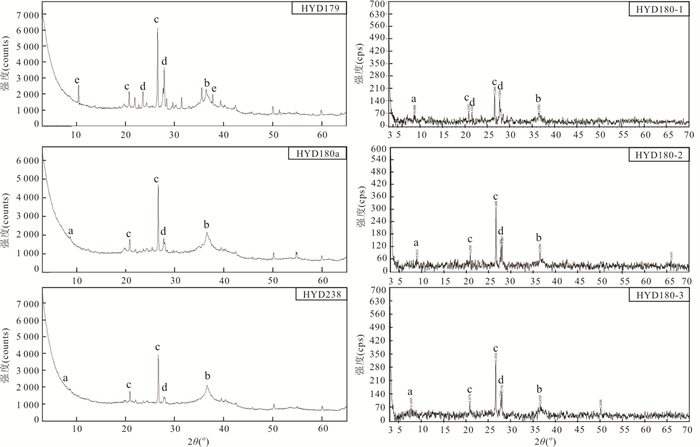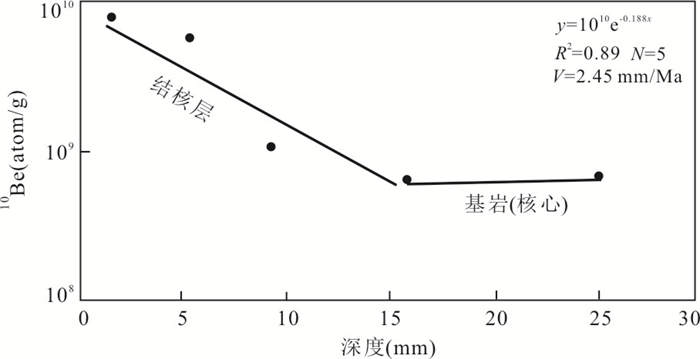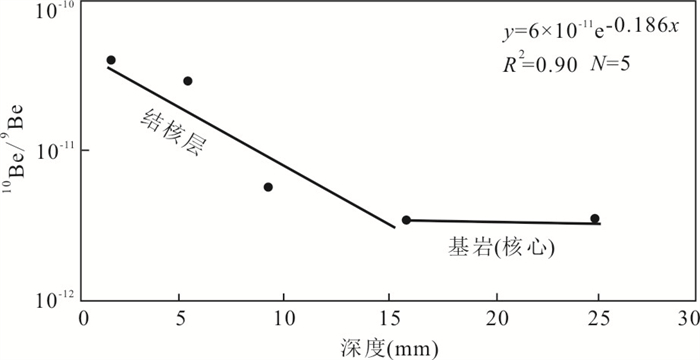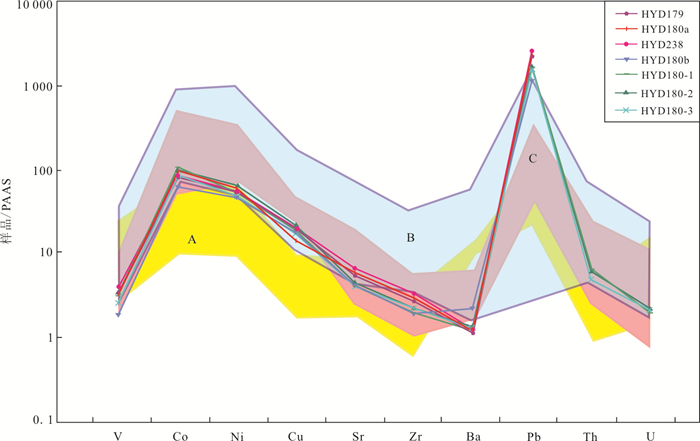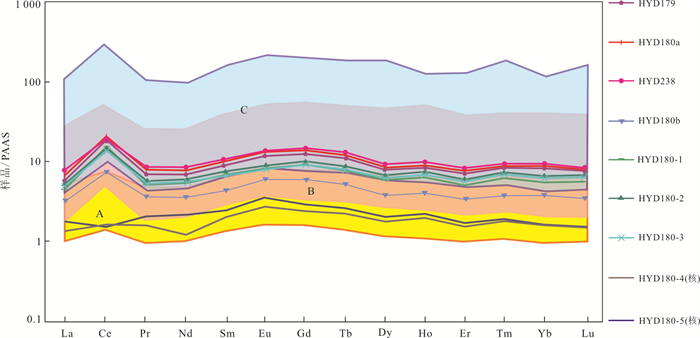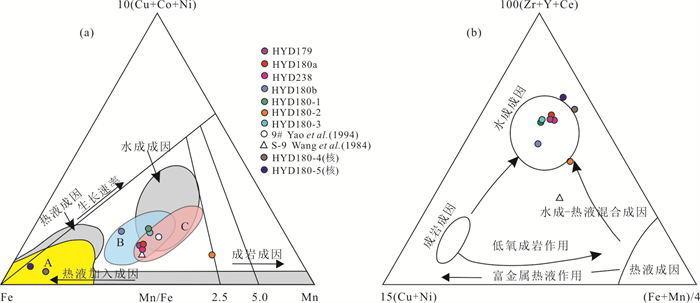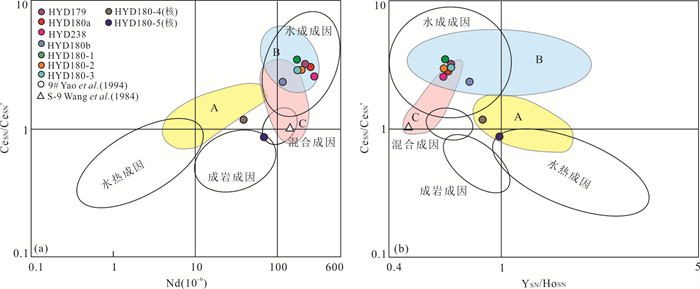Geochemical Characteristics and Genesis of Polymetallic Nodules (Crusts) in Seamount Chain of Eastern Subbasin, South China Sea
-
摘要: 为了进一步解释南海不同区域内多金属结核(壳)的地球化学特征与成因,对东部次海盆黄岩‒珍贝海山链上新获取的多金属结核(壳)样品进行了X光衍射、X荧光光谱测试、SEM-EDS分析和X Series2 ICP-MS测试,详细分析了样品的矿物组成、地球化学成分特征. 结果表明,矿物组成为水羟锰矿、石英、斜长石等;主要造岩元素中Si、Al含量较高,与陆缘碎屑物影响较大有关;富含Mn、Fe、Co、Ti、Ni、Pb、Sr等多种金属元素,相比南海其他区域,具有中等的Fe、Mn含量特征,地化元素特征与南海西北陆坡发现的铁锰结核(壳)相似;稀土元素具有总量高(平均2 070.01×10-6)的特点,高于南海北部其他样品,与西太平洋结壳稀土含量接近(接近工业品位),指示了重要的稀土资源前景. 结核Be同位素结果指示该区铁锰结核生长时代为1.17~8.51 Ma,形成于晚中新世大量火山喷发之后,因此水成作用是南海东部次海盆海山链结核(壳)的主要控制作用,而陆源物质的输入、火山作用和高压富氢离子海水的浸取作用都为结核(壳)的形成提供了有利的沉积环境.Abstract: In order to further explain the geochemical characteristics and genesis of polymetallic nodules (crusts) in different regions of the South China Sea, X-ray diffraction, X-ray fluorescence spectroscopy, SEM-EDS analysis and X-Series analysis were carried out on the newly obtained polymetallic nodules (crusts) from the Huangyan-Zhenbei seamount chain in the eastern Subbasin. The mineral composition and geochemical characteristics of polymetallic nodules (crusts) were analyzed by ICP-MS. The results show that the mineral compositions of polymetallic nodules (crusts) are hydroxidite, quartz and plagioclase, and the main rock forming elements are Si and Al. It is rich in Mn, Fe, Co, Ti, Ni, Pb, Sr, Cu and other metal elements. Compared with other areas in the South China Sea, it has the characteristics of medium Fe and Mn contents, and the geochemical element characteristics are similar to those of ferromanganese nodules (crusts) found in the northwest slope of the South China Sea. The REE content of nodules (crusts) in the study area is high (average 2 070.01×10-6), which is higher than other samples in the northern South China Sea, and close to the industrial grade of crusts in the West Pacific, indicating its important rare earth resource prospect. The results of Be isotope indicate that the age of Fe Mn nodules in this area is 1.17‒8.51 Ma, which was formed after a large number of volcanic eruptions in the Late Miocene. Therefore, the hydrogenesis is the main control of the seamount chain nodules (crusts) in the eastern Subbasin of the South China Sea, and the input of terrigenous materials, volcanism and leaching of high-pressure hydrogen rich seawater all provide favorable conditions for the formation of nodules (crusts).
-
Key words:
- polymetallic nodule (crust) /
- geochemical characteristics /
- REE /
- cause analysis /
- eastern subbasin /
- marine geology
-
图 1 南海渲晕地形图(a)以及样品位置分布(b)
图a改自Cao et al.(2017). 图b中S-9取自王贤觉等(1984),9#取自姚伯初等(1994);A、B、C三区参考Zhong et al.(2017)
Fig. 1. Colour relief map of the South China Sea (a) and sample location (b)
图 6 研究区铁锰氧化物中元素含量
黄色A区为南海东北部,蓝色B区代表南海西北区,粉色C区代表南海中央海盆(Zhong et al., 2017);下同
Fig. 6. Element contents for ferromanganese oxides in the study area
图 9 研究区铁锰结核(壳)成因三角图解(a)和大洋铁锰矿床成因分类判别图解(b)
a. 据Bonatti et al.(1972);b. 据Josso et al.(2017)
Fig. 9. Ternary diagram for the genetic classification of oceanic ferromanganese deposits (a) and discrimination diagram for the genetic classification of oceanic ferromanganese deposits (b)
图 10 研究区铁锰氧化物矿床相关图解
据Bau et al.(2014);SN为标准化后太古代澳大利亚页岩,PAAS据McLennan(1989)
Fig. 10. Discrimination graphs of Fe-Mn oxides in the study area
表 1 东部次海盆海山链结核(壳)站位
Table 1. Stations of the nodules (crusts) in the seamount chain of eastern subbasin
类型 站位号 地貌位置 水深(m) 结壳厚(mm) 基岩 资料来源 结壳 S-9 海盆平原 4 200 大洋玄武岩 王贤觉等(1984) 9# 珍贝海山 3 116 15~20 大洋玄武岩 姚伯初等(1994) HYD179 黄岩岛基座 3 273 50 玄武岩 本文 HYD180a 紫贝海山 2 430 10~30,最厚为50 玄武岩 HYD238 贝壳海山 3 043 15~20 玄武岩 HYD239 贝壳海山 3 093 10~20,最厚为50 玄武岩 结核 HYD180 黄岩岛基座 3 439 直径2~5 cm 表 2 研究区海山链结核(壳)常、微量元素分析结果(X荧光光谱仪)
Table 2. The analysis result of the common and trace elements in samples of study area
站位 常量元素(%) Na2O MgO Al2O3 SiO2 P2O5 K2O CaO TiO2 Mn Fe Mn/Fe Co Ni Cu HYD179 2.65 2.12 6.90 23.58 0.86 0.83 3.01 0.99 14.84 18.89 0.79 0.18 0.29 0.10 HYD180a 2.60 2.39 5.59 20.94 0.92 0.91 2.65 1.20 15.90 19.60 0.81 0.22 0.32 0.070 HYD238 2.29 2.02 3.78 17.48 1.01 0.65 2.60 1.02 17.61 21.80 0.81 0.19 0.30 0.10 HYD180b 3.83 3.88 15.79 33.07 0.66 1.27 6.74 2.32 7.07 12.61 0.56 0.14 0.25 0.087 HYD180--1 2.11 0.74 7.91 — 0.28 0.77 2.34 1.00 11.45 13.01 0.88 0.241 0.292 0.093 HYD180--2 1.84 0.27 0.78 — 0.28 0.98 2.07 0.88 40.21 17.55 2.29 0.223 0.350 0.106 HYD180--3 1.94 1.76 10.06 — 0.23 0.87 2.19 1.09 10.72 12.05 0.89 0.192 0.262 0.084 站位 微量元素(10-6) Zn V Sr Zr Ba Pb HYD179 584 498 1 065 558 723 2 193 HYD180a 574 472 1 173 616 779 2 386 HYD238 621 591 1 311 689 795 2 547 HYD180b 576 272 828 397 1 403 1 115 HYD180--1 450 465.31 815.75 411.12 780.00 1 604.63 HYD180--2 490 498.38 882.69 462.04 860.00 1 667.32 HYD180--3 450 383.84 806.91 451.70 820.00 1 547.06 注:HYD180-1、HYD180-2、HYD180-3是同一结核不同层位,HYD180b是块体混合样,与HYD180为同一站位不同样品. 表 3 研究区海山链结核(壳)中稀土元素含量(10-6)
Table 3. The contents of rare earth elements (10-6) in the seamount chain of study area
La Ce Pr Nd Sm Eu Gd Tb Dy Ho Er Tm Yb Lu Sc Y REE LREE HREE LREE/HREE Ce/Ce* Eu/Eu* YSN/HoSN HYD179 221 1 475 54.3 218 50.5 12.7 58.3 8.44 45.4 8.64 23.70 3.32 22.8 3.26 19.1 157 2 381.46 2 031.50 349.96 5.80 3.11 1.09 0.67 HYD180a 258 1 650 61.5 246 55.1 14.4 64.6 9.22 48.8 9.3 25.9 3.49 24.5 3.40 19.6 169 2 662.81 2 285 377.81 6.05 3.02 1.12 0.67 HYD238 299 1 553 67 270 59.7 14.9 68.8 9.98 53.4 10.2 28 3.74 26.2 3.56 16.1 174 2 657.58 2 263.6 393.98 5.75 2.53 1.08 0.63 HYD180b 124 591 28.4 113 23.9 6.56 27.9 3.96 21.7 4.16 11.40 1.49 10.5 1.47 21.7 88 1 079.14 886.86 192.28 4.61 2.30 1.18 0.78 HYD180-1 171.30 1 234.35 40.15 169.9 38.08 8.81 42.61 5.91 33.71 6.54 17.03 2.46 15.24 2.39 14.47 113.46 1 916.39 1 662.58 253.81 6.55 3.43 1.02 0.64 HYD180-2 200.61 1 177.3 44.6 191.06 41.86 9.77 46.98 6.65 38.78 7.71 20.11 2.93 18.42 2.92 14.12 132.76 1 956.58 1 665.21 291.37 5.72 2.87 1.03 0.63 HYD180-3 192.77 1 108.52 41.31 176.06 37.30 8.76 42.86 6.04 35.66 7.11 18.83 2.73 17.25 2.72 13.17 125.05 1 836.13 1 564.73 271.41 5.77 2.86 1.02 0.65 HYD180-4(核) 50.54 126.53 12.35 38.31 11.32 3.01 11.30 1.70 10.28 2.03 5.14 0.71 4.47 0.64 18.74 47.6 344.66 242.06 102.6 2.36 1.17 1.25 0.86 HYD180-5(核) 66.98 122.1 16.06 68.19 13.62 3.87 13.54 1.99 11.66 2.29 5.73 0.76 4.46 0.65 30.82 61.73 424.44 290.82 133.63 2.18 0.86 1.34 0.99 表 4 结核HYD180不同深度中10Be/9Be比值和10Be比活度分布
Table 4. The distribution of 10Be/9Be ratio and 10Be specific activity at different depths of HYD180
样品编号 取样深度 平均深度 样品质量 10Be/ 9Be 10Be (mm) (mm) (g) (10-12) (108 atom/g) HYD180-1 0~2.9 1.45 0.201 6 41.35 77.43 HYD180-2 2.9~7.6 5.25 0.200 3 29.70 56.03 HYD180-3 7.6~10.8 9.2 0.206 0 5.82 10.58 HYD180-4(核) 10.8~20.8 15.8 0.205 0 3.49 6.41 HYD180-5(核) 20.8~29.3 25.0 0.209 2 3.62 6.87 表 5 结核HYD180生成年代
Table 5. Generation ages of sample HYD180
样品编号 采样深度(mm) 生成年代(Ma B.P.) HYD180-1 0~2.9 1.17 HYD180-2 2.9~7.6 3.10 HYD180-3 7.6~10.8 4.41 HYD180-4 10.8~20.84 8.51 -
Bao, G. D., Li, Q. X., 1993. Geochemistry of Rare Earth Elements in Ferromanganese Nodules (Crusts) of the South China Sea. Oceanologia et Limnologia Sinica, 24(3): 304-313 (in Chinese with English abstract). Bau, M., Schmidt, K., Koschinsky, A., et al., 2014. Discriminating between Different Genetic Types of Marine Ferro-Manganese Crusts and Nodules Based on Rare Earth Elements and Yttrium. Chemical Geology, 381: 1-9. https://doi.org/10.1016/j.chemgeo.2014.05.004 Bonatti, E., Kraemer, T., Rydell, H., 1972. Classification and Genesis of Submarine Iron-Manganese Deposits. In: Horn, D. R., ed., Papers from a Conference on Ferromanganese Deposits on the Ocean Floor. Journal of National Science Foundation of Sri Lanka, 149-166. Bu, W. R., Shi, X. F., Peng, J. T., et al., 2001. Geochemical Constraints on the Formation Environment of Ferromanganese Nodules in the Central Pacific Seamount. Chinese Science Bulletin, 46(S1): 89-95 (in Chinese). doi: 10.1360/csb2001-46-S1-89 Cao, Y., Li, C. F., Yao, Y. J., 2017. Thermal Subsidence and Sedimentary Processes in the South China Sea Basin. Marine Geology, 394: 30-38. https://doi.org/10.1016/j.margeo.2017.07.022 Chen, H., Xie, X. N., Mao, K. N., et al., 2020. Depositional Characteristics and Formation Mechanisms of Deep-Water Canyon Systems along the Northern South China Sea Margin. Journal of Earth Science, 31(4): 808-819. https://doi.org/10.1007/s12583-020-1284-z Chen, J. R., 1984. Features of the Ferromanganese Nodules in the Beibu Gulf, the South China Sea. Marine Science Bulletin, 3(3): 46-50 (in Chinese with English abstract). Chen, Z., Yang, H. N., Yan, W., et al., 2006. Distributions and Divisions of Mineral Resources in the Sea Areas of China: Placer Deposit and Ferromanganese Nodule/Crust. Marine Geology & Quaternary Geology, 26(5): 101-108 (in Chinese with English abstract). Cronan, D. S., 2001. Manganese Nodules. Encyclopedia of Ocean Sciences, 1526-1533. Ding, W. W., 2021. Continental Margin Dynamics of South China Sea: From Continental Break-Up to Seafloor Spreading. Earth Science, 46(3): 790-800 (in Chinese with English abstract). Guan, Y., Sun, X. M., Ren, Y. Z., et al., 2017. Mineralogy, Geochemistry and Genesis of the Polymetallic Crusts and Nodules from the South China Sea. Ore Geology Reviews, 89: 206-227. https://doi.org/10.1016/j.oregeorev.2017.06.020 Halbach, P., Scherhag, C., Hebisch, U., et al., 1981. Geochemical and Mineralogical Control of Different Genetic Types of Deep-Sea Nodules from the Pacific Ocean. Mineralium Deposita, 16(1): 59-84. https://doi.org/10.1007/BF00206455 Hein, J. R., Schwab, W. C., Davis, A. S., 1988. Cobalt- and Platinum-Rich Ferromanganese Crusts and Associated Substrate Rocks from the Marshall Islands. Marine Geology, 78(3-4): 255-283. https://doi.org/10.1016/0025-3227(88)90113-2 Jauhari, P., Pattan, J. N., 2000. Ferromanganese Nodules from the Central Indian Ocean Basin. In: Cronan, D. S., ed., Handbook of Marine Mineral Deposits. The Chemical Rubber Company Press, Boca Raton, 171-195. Josso, P., Pelleter, E., Pourret, O., et al., 2017. A New Discrimination Scheme for Oceanic Ferromanganese Deposits Using High Field Strength and Rare Earth Elements. Ore Geology Reviews, 87: 3-15. https://doi.org/10.1016/j.oregeorev.2016.09.003 Koschinsky, A., Halbach, P., 1995. Sequential Leaching of Marine Ferromanganese Precipitates: Genetic Implications. Geochimica et Cosmochimica Acta, 59(24): 5113-5132. https://doi.org/10.1016/0016-7037(95)00358-4 Lai, L. R., 1995. Disscusion on the Genesis of Manganese Nodules of the South China Sea. Mineral Resources and Geology, 9(4): 293-298 (in Chinese). Li, C. F., Xu, X., Lin, J., et al., 2014. Ages and Magnetic Structures of the South China Sea Constrained by Deep Tow Magnetic Surveys and IODP Expedition 349. Geochemistry, Geophysics, Geosystems, 15(12): 4958-4983. https://doi.org/10.1002/2014gc005567 Li, Z. L., Qiu, Z. L., Qin, S. C., et al., 1991. A Study on the Forming Conditions of Basalts in Seamounts of the South China Sea. Acta Mineralogica Sinica, 11(4): 325-333, 441 (in Chinese with English abstract). Liang, H. F., Yao, D., Liu, X. B., et al., 1991. Geochemistry of Polymetallic Crust from Jianfeng Seamount, South China Sea. Marine Geology & Quaternary Geology, 11(4): 49-58 (in Chinese with English abstract). Lin, Z. H., Ji, F. W., Zhang, F. Y., et al., 2003. Characteristics and Origin of Ferromanganese Nodules from the Northeastern Continental Slope of the South China Sea. Marine Geology & Quaternary Geology, 23(1): 7-12 (in Chinese with English abstract). Liu, X. J., Tang, D. H., Yan, P., et al., 2019. Mineralogy and Geochemisry of Ferromanganese Crusts from Guanshi Seamount in the Eastern South China Sea. Marine Geology & Quaternary Geology, 39(3): 94-103 (in Chinese with English abstract). Liu, X. S., Chen, X. G., Sun, K., et al., 2021. Provenance of U1431 Sediments from the Eastern Subbasin of the South China Sea since Middle Miocene. Earth Science, 46(3): 1008-1022 (in Chinese with English abstract). Liu, Z. F., Zhao, Y. L., Colin, C., et al., 2016. Source-to-Sink Transport Processes of Fluvial Sediments in the South China Sea. Earth-Science Reviews, 153: 238-273. https://doi.org/10.1016/j.earscirev.2015.08.005 Manheim, F. T., 1986. Marine Cobalt Resources. Science, 232(4750): 600-608. https://doi.org/10.1126/science.232.4750.600 McLennan, S. M., 1989. Rare Earth Elements in Sedimentary Rocks: Influence of Provenance and Sedimentary Processes. In: Lipen, B. R., McKay, G. A., eds., Geochemistry and Mineralogy of Rare Earth Elements, Review in Mineralogy and Geochemistry. Mineralogical Society of America, Washington D. C., 169-200. Menendez, A., James, R. H., Lichtschlag, A., et al., 2019. Controls on the Chemical Composition of Ferromanganese Nodules in the Clarion-Clipperton Fracture Zone, Eastern Equatorial Pacific. Marine Geology, 409: 1-14. https://doi.org/10.1016/j.margeo.2018.12.004 Pan, J. H., Liu S. Q., 1999. Distribution, Composition and Element Geochemistry of Co-Rich Crusts in the Western Pacific. Acta Geoscientia Sinica (Bulletin of the Chinese Academy of Geological Sciences), 20(1): 47-54 (in Chinese with English abstract). Piper, D. Z., 1974. Rare Earth Elements in Ferromanganese Nodules and Other Marine Phases. Geochimica et Cosmochimica Acta, 38(7): 1007-1022. https://doi.org/10.1016/0016-7037(74)90002-7 Ren, J. B., He, G. W., Yao, H. Q., et al., 2016. Geochemistry and Significance of REE and PGE of the Cobalt-Rich Crusts from West Pacific Ocean Seamounts. Earth Science, 41(10): 1745-1757 (in Chinese with English abstract). Shi, X. F., Yan, Q. S., 2011. Geochemistry of Cenozoic Magmatism in the South China Sea and Its Tectonic Implications. Marine Geology & Quaternary Geology, 31(2): 59-72 (in Chinese with English abstract). Von Heimendahl, M., Hubred, G. L., Fuerstenau, D. W., et al., 1976. A Transmission Electron Microscope Study of Deep-Sea Manganese Nodules. Deep Sea Research and Oceanographic Abstracts, 23(1): 69-79. https://doi.org/10.1016/0011-7471(76)90809-3 Wang, X. J., Chen, Y. W., Wu, M. Q., 1984. Geochemistry of RE and Trace Elements in Ferromanganese Nodules and Their Genesis. Oceanologia et Limnologia Sinica, 15(6): 501-514 (in Chinese with English abstract). Wang, Y. J., Han, X. Q., Luo, Z. H., et al., 2009. Late Miocene Magmatism and Evolution of Zhenbei-Huangyan Seamount in the South China Sea: Evidence from Petrochemistry and Chronology. Acta Oceanologica Sinica, 31(4): 93-102 (in Chinese with English abstract). Wegorzewski, A. V., Kuhn, T., 2014. The Influence of Suboxic Diagenesis on the Formation of Manganese Nodules in the Clarion Clipperton Nodule Belt of the Pacific Ocean. Marine Geology, 357: 123-138. https://doi.org/10.1016/j.margeo.2014.07.004 Wei, J. X., 2015. Ⅰ. High-Precision Measurement of Boron Isotope of Silicate Materials and Its Application Ⅱ. Geochronological and Geochemical Studies on Cenozoic Basalts from South China Sea Seamounts (Dissertation). University of Chinese Academy of Sciences (Guangzhou Institute of Chemistry, Chinese Academy of Sciences), Guangzhou (in Chinese with English abstract). Wei, Z. Q., He, G. W., Deng, X. G., et al., 2017. The Progress in the Study and Survey of Oceanic Cobalt-Rich Crust Resources. Geology in China, 44(3): 460-472 (in Chinese with English abstract). Wu, S. Y., Zeng, W. Y., Shi, C. T., et al., 1998. Determination of 10Be in Manganese Nodule Samples Using Accelerator Mass Spectrometry. Journal of Oceanography in Taiwan Strait, 17(2): 185-189 (in Chinese with English abstract). Xie, S. P., Xie, Q., Wang, D. X., et al., 2003. Summer Upwelling in the South China Sea and Its Role in Regional Climate Variations. Journal of Geophysical Research, 108(C8): 1-13. https://doi.org/10.1029/2003jc001867 Xu, Y. G., Wei, J. X., Qiu, H. N., et al., 2012. Opening and Evolution of the South China Sea Constrained by Studies on Volcanic Rocks: Preliminary Results and a Research Design. Chinese Science Bulletin, 57(24): 3150-3164. https://doi.org/10.1007/s11434-011-4921-1 Yao, B. C., Zeng, W. J., Hayes, D. E., et al., 1994. The Geological Memoir of South China Sea Surveyed Jointly by China and the U. S. A. . China University of Geosciences Press, Wuhan (in Chinese). Yin, Z. X., Wang, H. F., Han, J. S., et al., 2019. Comparison between the Marginal-Sea Polymetallic Nodules in South China Sea and Ocean Polymetallic Nodules. Journal of Jilin University (Earth Science Edition), 49(1): 261-277 (in Chinese with English abstract). Zhang, F. Y., Zhang, X. Y., Yang, Q. H., et al., 2005. Research on Sedimentations and Material Sources in the Eastern South China Sea. Acta Oceanologica Sinica, 27(2): 79-90 (in Chinese with English abstract). Zhang, Z. G., Du, Y. S., Wu, C. H., et al., 2013. Growth of a Polymetallic Nodule from Northwestern Continental Margin of the South China Sea and Its Response to Changes in Paleoceanographical Environment of the Late Cenozoic. Scientia Sinica Terrae, 43(7): 1168-1178 (in Chinese). doi: 10.1360/zd-2013-43-7-1168 Zhang, Z. G., Gao, L. F., Li, C. C., et al., 2011. Enrichment Characteristics and Resource Effects of Rare Earth Elements in Polymetallic Nodules/Crusts. Journal of the Chinese Society of Rare Earths, 29(5): 630-636 (in Chinese with English abstract). Zhang, Z. G., Fang, N. Q., Du, Y. S., et al., 2009. Geochemical Characteristics and Their Causative Mechanism of Polymetallic Nodules from the Northwest Continental Margin of the South China Sea. Earth Science, 34(6): 955-962 (in Chinese with English abstract). Zhuang, D. D., Chu, F. Y., Zhu, J. H., 2015. The Origin of the Opal-Layer Full of Todorokite Veinlets in Polymetallic Nodules from the Eastern Pacific Ocean. Journal of Marine Sciences, 33(2): 19-29 (in Chinese with English abstract). Zhong, Y., Chen, Z., González, F. J., et al., 2017. Composition and Genesis of Ferromanganese Deposits from the Northern South China Sea. Journal of Asian Earth Sciences, 138: 110-128. https://doi.org/10.1016/j.jseaes.2017.02.015 鲍根德, 李全兴, 1993. 南海铁锰结核(壳)的稀土元素地球化学. 海洋与湖沼, 24(3): 304-313. doi: 10.3321/j.issn:0029-814X.1993.03.013 卜文瑞, 石学法, 彭建堂, 等, 2001. 中太平洋海山铁锰结核形成环境的地球化学制约. 科学通报, 46(增刊): 89-95. https://www.cnki.com.cn/Article/CJFDTOTAL-KXTB2001S1014.htm 陈俊仁, 1984. 南海北部湾铁锰结核特征. 海洋通报, 3(3): 46-50. https://www.cnki.com.cn/Article/CJFDTOTAL-HUTB198403005.htm 陈忠, 杨慧宁, 颜文, 等, 2006. 中国海域固体矿产资源分布及其区划: 砂矿资源和铁锰(微)结核‒结壳. 海洋地质与第四纪地质, 26(5): 101-108. https://www.cnki.com.cn/Article/CJFDTOTAL-HYDZ200605017.htm 丁巍伟, 2021. 南海大陆边缘动力学: 从陆缘破裂到海底扩张. 地球科学, 46(3): 790-800. doi: 10.3799/dqkx.2020.303 赖来仁, 1995. 中国南海锰结核的成因探讨. 矿产与地质, 9(4): 293-298. https://www.cnki.com.cn/Article/CJFDTOTAL-KCYD1995Z1015.htm 李兆麟, 丘志力, 秦社彩, 等, 1991. 南海海山玄武岩形成条件研究. 矿物学报, 11(4): 325-333, 441. doi: 10.3321/j.issn:1000-4734.1991.04.005 梁宏锋, 姚德, 刘新波, 等, 1991. 南海尖峰海山多金属结壳地球化学. 海洋地质与第四纪地质, 11(4): 49-58. https://www.cnki.com.cn/Article/CJFDTOTAL-HYDZ199104007.htm 林振宏, 季福武, 张富元, 等, 2003. 南海东北陆坡区铁锰结核的特征和成因. 海洋地质与第四纪地质, 23(1): 7-12. https://www.cnki.com.cn/Article/CJFDTOTAL-HYDZ200301002.htm 刘兴健, 唐得昊, 阎贫, 等, 2019. 南海东部管事海山铁锰结壳的矿物组成和地球化学特征. 海洋地质与第四纪地质, 39(3): 94-103. https://www.cnki.com.cn/Article/CJFDTOTAL-HYDZ201903009.htm 刘雪松, 陈雪刚, 孙凯, 等, 2021. 南海东部次海盆U1431站位中中新世以来的沉积物来源特征. 地球科学, 46(3): 1008-1022. doi: 10.3799/dqkx.2020.290 潘家华, 刘淑琴, 1999. 西太平洋富钴结壳的分布、组分及元素地球化学. 地球学报, 20(1): 47-54. doi: 10.3321/j.issn:1006-3021.1999.01.007 任江波, 何高文, 姚会强, 等, 2016. 西太平洋海山富钴结壳的稀土和铂族元素特征及其意义. 地球科学, 41(10): 1745-1757. doi: 10.3799/dqkx.2016.503 石学法, 鄢全树, 2011. 南海新生代岩浆活动的地球化学特征及其构造意义. 海洋地质与第四纪地质, 31(2): 59-72. https://www.cnki.com.cn/Article/CJFDTOTAL-HYDZ201102011.htm 王贤觉, 陈毓蔚, 吴明清, 1984. 铁锰结核的稀土和微量元素地球化学及其成因. 海洋与湖沼, 15(6): 501-514. https://www.cnki.com.cn/Article/CJFDTOTAL-HYFZ198406000.htm 王叶剑, 韩喜球, 罗照华, 等, 2009. 晚中新世南海珍贝‒黄岩海山岩浆活动及其演化: 岩石地球化学和年代学证据. 海洋学报(中文版), 31(4): 93-102. doi: 10.3321/j.issn:0253-4193.2009.04.011 魏静娴, 2015. Ⅰ. 硅酸盐高精度B同位素测定方法的建立及其应用Ⅱ. 南海海山玄武岩的年代学和地球化学研究(博士学位论文). 广州: 中国科学院大学(中国科学院广州地球化学研究所). 韦振权, 何高文, 邓希光, 等, 2017. 大洋富钴结壳资源调查与研究进展. 中国地质, 44(3): 460-472. https://www.cnki.com.cn/Article/CJFDTOTAL-DIZI201703006.htm 吴世炎, 曾文义, 施纯坦, 等, 1998. 加速器质谱法测定深海锰结核样品中的10Be. 台湾海峡, 17(2): 185-189. https://www.cnki.com.cn/Article/CJFDTOTAL-TWHX199802012.htm 姚伯初, 曾维军, Hayes, D. E., 等, 1994. 中美合作调研南海地质专报. 武汉: 中国地质大学出版社. 殷征欣, 王海峰, 韩金生, 等, 2019. 南海边缘海多金属结核与大洋多金属结核对比. 吉林大学学报(地球科学版), 49(1): 261-277. https://www.cnki.com.cn/Article/CJFDTOTAL-CCDZ201901025.htm 张富元, 张霄宇, 杨群慧, 等, 2005. 南海东部海域的沉积作用和物质来源研究. 海洋学报(中文版), 27(2): 79-90. doi: 10.3321/j.issn:0253-4193.2005.02.010 张振国, 杜远生, 吴长航, 等, 2013. 南海西北陆缘大型多金属结核的生长过程及其对晚新生代古海洋环境变化的响应. 中国科学: 地球科学, 43(7): 1168-1178. https://www.cnki.com.cn/Article/CJFDTOTAL-JDXK201307011.htm 张振国, 高莲凤, 李昌存, 等, 2011. 多金属结核/结壳中稀土元素的富集特征及其资源效应. 中国稀土学报, 29(5): 630-636. https://www.cnki.com.cn/Article/CJFDTOTAL-XTXB201105021.htm 张振国, 方念乔, 杜远生, 等, 2009. 南海西北陆缘多金属结核地球化学特征及成因. 地球科学, 34(6): 955-962. doi: 10.3321/j.issn:1000-2383.2009.06.010 庄丹丹, 初凤友, 朱继浩, 2015. 东太平洋多金属结核富钡镁锰矿细脉蛋白石层的成因机制. 海洋学研究, 33(2): 19-29. doi: 10.3969/j.issn.1001-909X.2015.02.004 -









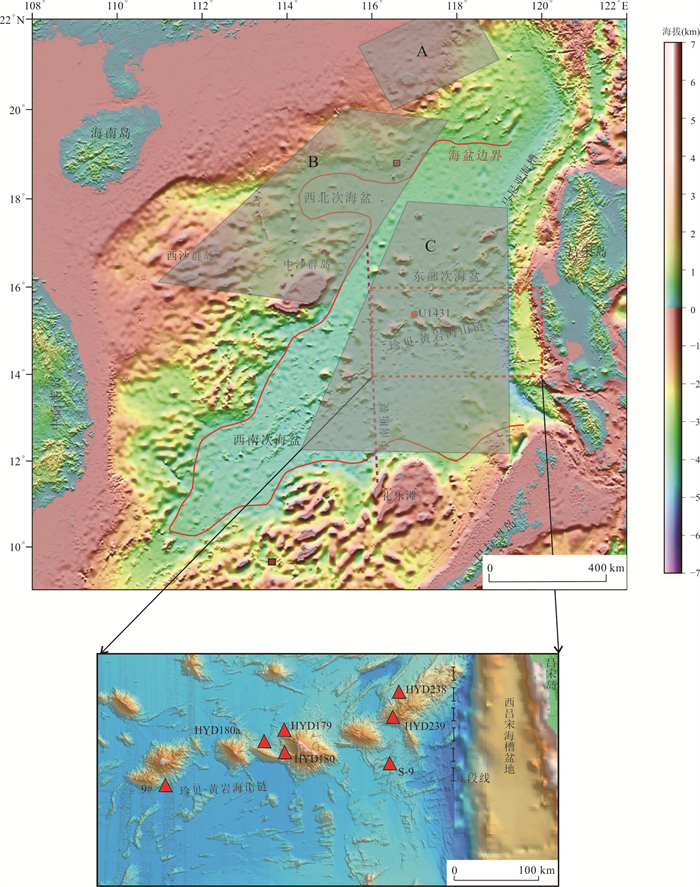
 下载:
下载:

